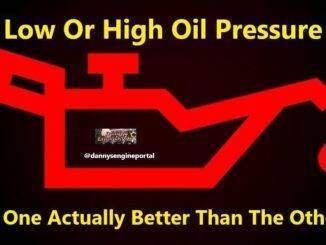
Engine oil leaks, can simply be minor annoyances, or they can be serious threats, to the life of your engine.
So, having engine oil leaks, means that you have, less lubricant inside the engine. And, that can lead to, serious problems down the road.
Another way you might spot, engine oil leaks is, when you open the hood to check your vehicle’s fluids. Consequently, you may see oil leaking or seeping from the engine, in all sorts of places.
But, the most obvious sign that you have engine oil leaks, is a dark brown puddle under your engine.
When checking your engine for oil leaks, start with the best case scenario. With luck, you’ll find an external engine oil leak. When searching for an external leak, keep gravity in mind.
If you spot drips on the oil pan, trace them back to their original source. They are more than likely coming from, above the oil pan. And, even the smallest leak can cause, excess oil consumption.
Engine oil leaks, can be difficult to find, because they can travel from their original location.
How Can You Tell If You Have, Engine Oil Leaks
Here Are Some Common Indicators:
- The tell-tale puddle, below your engine. Red liquid, means that the leak, is probably transmission fluid. Green or orange with a sweet smell, is likely to be coolant. And, brown is most likely engine oil. This may be more noticeable if your car has been, sitting overnight.
- Check your oil levels regularly, by removing the dipstick. If the level drops very quickly (like in a week or overnight), you probably have an engine oil leak.
- Watch for blue smoke out of your, exhaust pipe.
- After you have driven for a while, sniff around the engine and see if you can smell, burning oil. It will have a very distinct smell!
How To Find Engine Oil Leaks, Using A UV Leak Detector Kit
So, the fastest way to spot a leak, is to use a leak detector kit. These kits come with fluorescent dyes, that are formulated for specific engine fluids and a UV light.
When the oil starts coming out of the source of the leak, the fluorescent dye will leak out with it. Shining the UV light around the engine bay, will make the dye glow. And, is usually a fluorescent green that is easy to spot.
Now that you have determined that you do, in fact have, engine oil leaks, you are probably wondering why?
After six or seven years of service, the engine may start to leak oil. The older the engine, the more likely it is to leak oil, due to aging gaskets and seals. As an engine ages, heat can cause cork gaskets to harden and shrink.
And, heat can also cause rubber (neoprene) gaskets and seals to, harden and lose elasticity. Consequently, leaks occur most often at, the valve cover, oil pan or timing chain cover. As well as, the front and rear crankshaft seals.
Engine Oil Leaks, Can Also Occur From:
- Overfilled engine oil level
- A Clogged, (PCV) system
When oil leaks out of an engine, it attracts dirt. So, look for greasy stains, around or below gasket seams and seals.
Sometimes you can see oil dripping, while the engine is idling. But, more often than not, the oil just slowly seeps out. And, causes, a grease buildup, in the vicinity of the leak.
Tips And Recommendations
Crankcase oil additives, can sometimes help slow engine oil leaks, by causing aged gaskets and seals to swell. But, no additive will stop a major leak or repair a broken gasket or worn seal. So, sooner or later, you will have to replace the leaking gasket or seal.
The first and most important job, is to make sure the sealing surfaces, are clean and flat. Be careful cleaning aluminum. Never use abrasive discs, to remove the old material. Because, even the use of rough sandpaper, can prevent a gasket from sealing.
Different gaskets have different application recommendations and requirements. Consequently, most gaskets and seals will have, instructions included. Never go outside of the recommendations if possible. Because, you may be doing more harm than good on a modern engine.
Furthermore, do not overtighten oil pan bolts, as this may crush and damage the new gasket. Consequently, causing new engine oil leaks. Always, use an accurate torque wrench, and follow the vehicle manufacturer’s torque specs.
Some engines have bolts, that come with a torque spec and a torque angle spec. The bolts for these pans are, torque-to-yield. Consequently, the gasket will leak, if the bolts are reused.
When sealing up an oil leak, use a sealant that is a low volatile silicone, approved for use with oxygen (O2) sensors. Subsequently, some silicones contain chemicals, that can be drawn through the engine’s (PCV) system and contaminate the oxygen (O2) sensor.
So, to replace a leaky seal on the front of the crankshaft, the crank pulley/harmonic balancer must be removed. Most often, before the seal can be pried out, which requires a gear puller. Do not pound on the pulley/balancer, because this may damage it. Also, if the surface of the crankshaft is worn, a slip-on repair sleeve can be installed to restore the surface.
Leaky rear main crankshaft oil seals, are time consuming to replace. Because, they involve dropping the oil pan and unbolting, the rear main crankshaft support cap inside the engine. On some applications there is a one-piece rear main oil seal, instead of a split seal. Then, the flywheel has to come off, which means pulling the transmission.
The Most Common Places To Look For Leaks Include:
- Oil Fill Cap
- Oil Filter
- Pan Drain Plug
- Oil Pressure Sensor
- Valve Cover
- Front Crankshaft Main Seal
- Timing Cover Gasket
- Rear Crankshaft Seal
- Engine Oil Cooler Adapter
- Oil Level Sender
- Oil Pan
- Intake Manifold
- Head Gasket
- Distributor
In Summary: Engine Oil Leaks
Sometimes there are, other reasons for engine oil leaks. Damage caused to the oil sump, when driving over debris, potholes, or even damage sustained during a fender bender.
Finally, stick to your car’s service schedule, check your oil regularly and keeping an eye out for leaks. Then, you can protect your engine from the, devastating effects of an unnoticed oil leak.
Thank You !!




